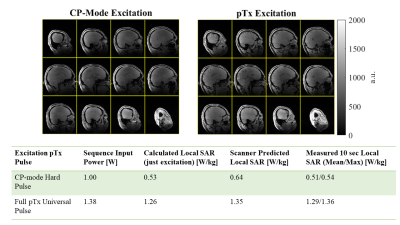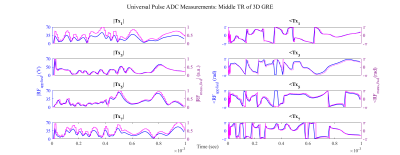Sydney Nicole Williams1, Sarah Allwood-Spiers2, Paul McElhinney1, Yuehui Tao3, John E. Foster2, Shajan Gunamony1,4, and David A. Porter1
1Imaging Centre of Excellence, University of Glasgow, Glasgow, United Kingdom, 2MRI Physics, NHS Greater Glasgow & Clyde, Glasgow, United Kingdom, 3Siemens Healthcare Ltd., Glasgow, United Kingdom, 4MR CoilTech Limited, Glasgow, United Kingdom
1Imaging Centre of Excellence, University of Glasgow, Glasgow, United Kingdom, 2MRI Physics, NHS Greater Glasgow & Clyde, Glasgow, United Kingdom, 3Siemens Healthcare Ltd., Glasgow, United Kingdom, 4MR CoilTech Limited, Glasgow, United Kingdom
We present a set of experimental tests to validate time varying dynamic parallel transmit (pTx) to ensure the safety of a self-built 8Tx/32Rx coil for 7T MRI. We show preliminary results of full waveform pTx in a healthy volunteer.

Figure 5. Example of the first full-waveform pTx scan in vivo after following validation tests outlined in this abstract. Here, a conventional 3D GRE sequence with a CP-mode hard pulse is compared to a Universal Pulse based on a 3D SPINS trajectory. Both pulses were set to a nominal flip angle of 5° and their reported SAR values are outlined as well.

Figure 3. Comparison of prescribed pTx RF pulse (blue) and normalized measurement waveforms (magenta) of the UP applied in the center-most TR of the 3D gradient-echo sequence. The left set of columns show the magnitude plots for 4/8 channels and right columns show the corresponding phase data. Some deviations between the prescribed and measured data exist for these more complex waveforms, yet in general are still in good agreement.
